Page 160 of 356
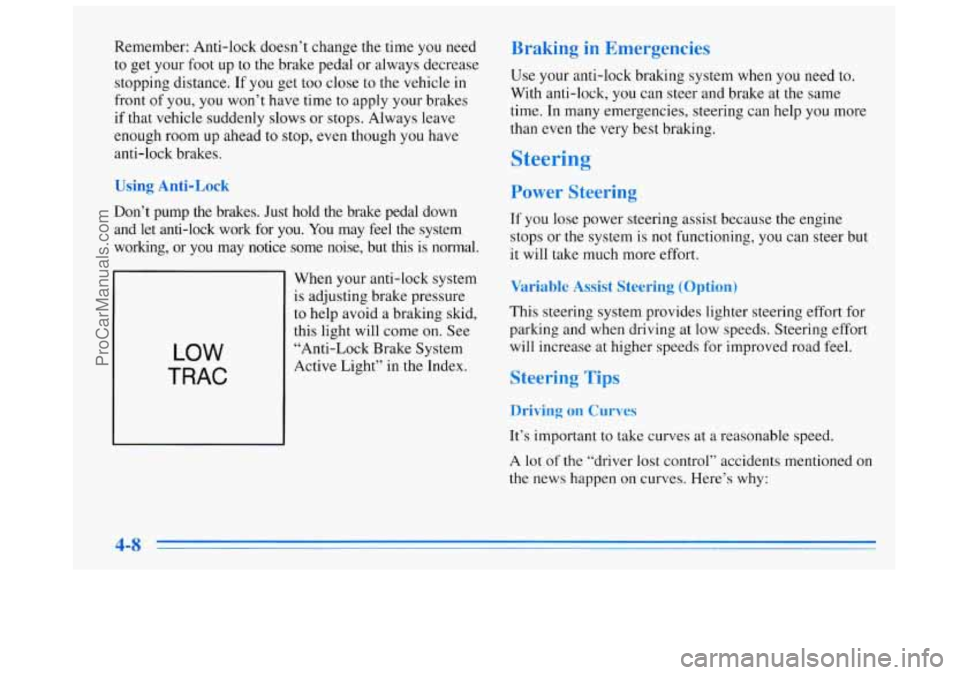
Remember: Anti-lock doesn’t change the time you need
to get your foot up to the brake pedal or always decrease
stopping distance. If
you get too close to the vehicle in
front of you, you won’t have time to apply your brakes
if that vehicle suddenly slows or stops. Always leave
enough room up ahead
to stop, even though you have
anti-lock brakes.
Using Anti-Lock
Don’t pump the brakes. Just hold the brake pedal down
and let anti-lock work for you. You may feel the system
working, or you may notice some noise, but this is normal.
LOW
TRAC
When your anti-lock system
is adjusting brake pressure
to help avoid a braking skid,
this light will come on. See
“Anti-Lock Brake System
Active Light” in the Index.
Braking in Emergencies
Use your anti-lock braking system when you need to.
With anti-lock, you can steer and brake at the same
time. In many emergencies, steering can
help you more
than even the very best braking.
Steering
Power Steering
If you lose power steering assist because the engine
stops or the system is not functioning, you can steer but
it will take much more effort.
Variable Assist Steering (Option)
This steering system provides lighter steering effort for
parking and when driving at low speeds. Steering effort
will increase at higher speeds for improved road feel.
Steering Tips
Driving on Curves
It’s important to take curves at a reasonable speed.
A lot of the “driver lost control” accidents mentioned on
the news happen on curves. Here’s why:
ProCarManuals.com
Page 230 of 356
When you open the hood on the 3.1L L82 engine, you'll see:
D
A. Engine Coolant E. Engine Oil Dipstick I. Windshield Washer
Recovery Tank F. Automatic Transaxle Dipstick
Fluid Reservoir
B. Radiator Fill
Cap G. Brake Fluid Reservoir J. Battery (located under
C. Power Steering Reservoir
H. Air Filter Windshield Washer
D. Engine Oil Fill
Cap Fluid Reservoir)
ProCarManuals.com
Page 231 of 356
When you open the hood of the 3.8L L36 engine, you’ll see:
r
A. Engine Coolant
Recovery Tank
B. Radiator Fill Cap
C. Power Steering Reservoir
D. Engine Oil Dipstick
It‘ A
E. Engine Oil Fill Cap
F. Automatic Transaxle Dipstick
G. Brake Fluid Reservoir
H. Air Filter
I. Windshield Washer
Fluid Reservoir
J. Battery (located under
Windshield Washer Fluid
Reservoir)
6-9
ProCarManuals.com
Page 246 of 356
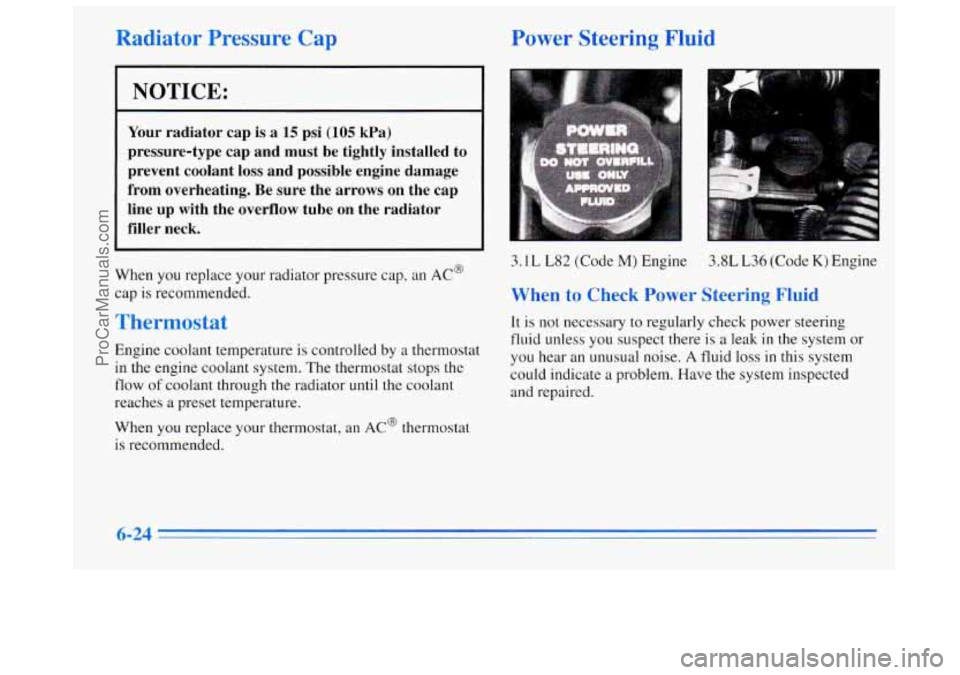
Radiator Pressure Cap
NOTICE:
Your radiator cap is a 15 psi (105 kPa)
pressure-type cap and must be tightly installed to
prevent coolant loss and possible engine damage
from overheating. Be sure the arrows on the cap
line up with the overflow tube on the radiator filler neck.
When you replace your radiator pressure cap, an AC@
cap is recommended.
Thermostat
Engine coolant temperature is controlled by a thermostat
in the engine coolant system. The thermostat stops the
flow of coolant through the radiator until the coolant
reaches
a preset temperature.
When
you replace your thermostat, an AC@ thermostat
is recommended.
Power Steering Fluid
3.lL L82 (Code M) Engine 3.8L L36 (Code K) Engine
When to Check Power Steering Fluid
It is not necessary to regularly check power steering
fluid unless
you suspect there is a leak in the system or
you hear an unusual noise.
A fluid loss in this system
could indicate a problem. Have the system inspected
and repaired.
6-24
ProCarManuals.com
Page 247 of 356
How To Check Power Steering Fluid
When the engine compartment is cool, unscrew the cap
and wipe the dipstick with a clean rag. Replace the cap
and completely tighten it. Then remove the cap again
and
look at the fluid level on the dipstick.
3.1 L L82 (Code M) Engine When
the engine
compartment
is hot,
the level should be at the
H mark. When it’s cold,
the level should be at the
C mark. If the fluid is at
the ADD mark, you
should add fluid. 3.8L L36 (Code K) Engine
When the engine compartment is hot, the level should be
at the
HOT mark. When it’s cold, the level should be at
the FULL COLD mark, If the fluid is at the
ADD mark, you should add fluid.
What to Use
Refer to the Maintenance Schedule to determine what
kind
of fluid to use. See “Recommended Fluids and
Lubricants”
in the Index. Always use the proper fluid.
Failure to use
the proper fluid can cause leaks and
damage hoses and seals.
ProCarManuals.com
Page 277 of 356
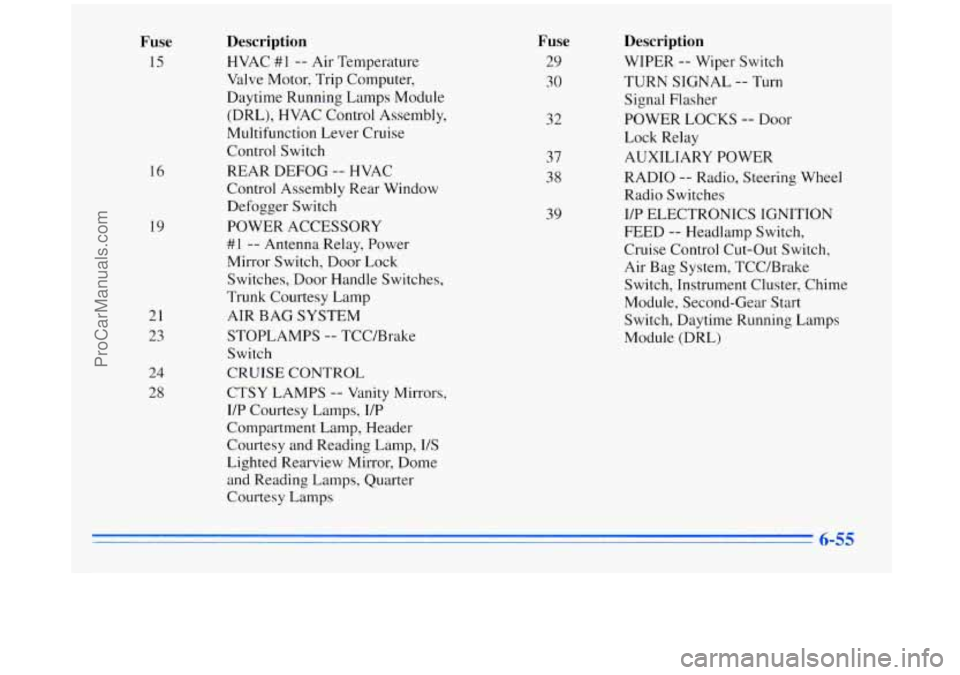
Fuse
15
16
19
21
23
24
28
Description
HVAC #1 -- Air Temperature
Valve Motor: Trip Computer,
Daytime Running Lamps Module
(DRL), HVAC Control Assembly,
Multifunction Lever Cruise
Control Switch
Control Assembly Rear Window
Defogger Switch
POWER ACCESSORY
#1 -- Antenna Relay, Power
Mirror Switch, Door Lock
Switches,
Door Handle Switches,
Trunk Courtesy Lamp
AIR BAG SYSTEM
STOPLAMPS
-- TCC/Brake
Switch
CRUISE CONTROL
CTSY LAMPS -- Vanity Mirrors,
T/P Courtesy Lamps, I/P
Compartment Lamp, Header
Courtesy and Reading Lamp,
I/S
Lighted Rearview Mirror, Dome
and Reading Lamps, Quarter
Courtesy Lamps
REAR
DEFOG
-- HVAC
Fuse
29
30
32
37
38
39
Description
WIPER -- Wiper Switch
TURN SIGNAL
-- Turn
Signal Flasher
POWER LOCKS
-- Door
Lock Relay
AUXILIARY POWER
RADIO
-- Radio, Steering Wheel
Radio Switches
I/P ELECTRONICS IGNITION
FEED
-- Headlamp Switch,
Cruise Control Cut-Out Switch,
Air Bag System, TCC/Brake
Switch, Instrument Cluster, Chime
Module, Second-Gear Start
Switch, Daytime Running Lamps
Module (DRL)
6-55
ProCarManuals.com
Page 325 of 356
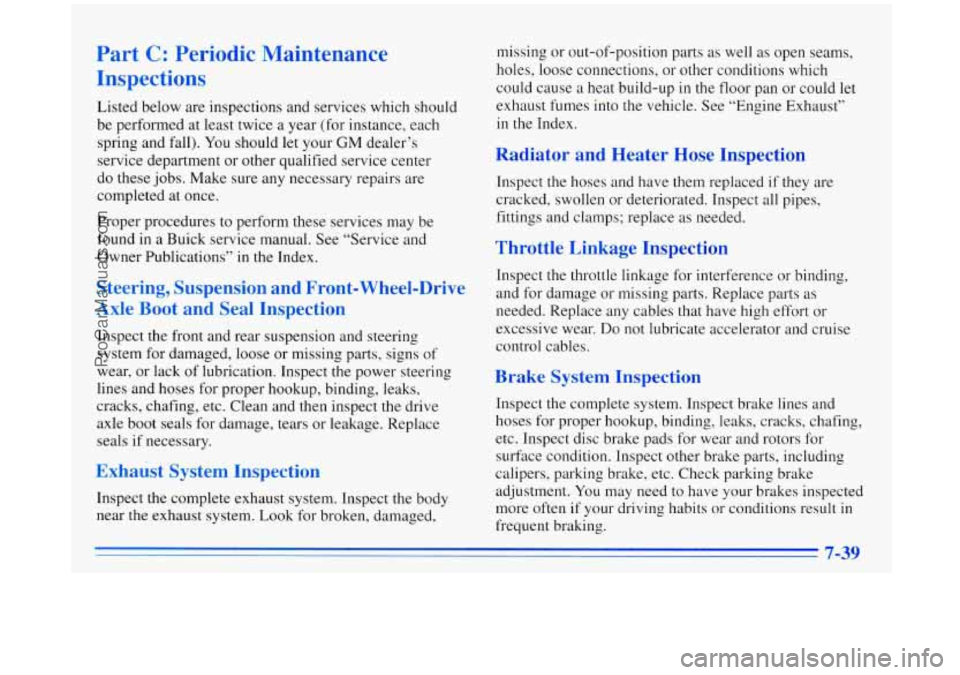
Part C: Periodic Maintenance
Inspections
Listed below are inspections and services which should
be performed at least twice
a year (for instance, each
spring and fall). You should let your GM dealer’s
service department or other qualified service center
do these jobs. Make sure any necessary repairs are
completed at once.
Proper procedures to perform these services may be
found in a Buick service manual. See “Service and
Owner Publications’’ in the Index.
Steering, Suspension and Front- Wheel-Drive
Axle Boot and Seal Inspection
Inspect the front and rear suspension and steering
system for damaged, loose or missing parts, signs of
wear, or lack of lubrication. Inspect the power steering
lines and hoses for proper hookup, binding, leaks,
cracks, chafing, etc. Clean and then inspect
the drive
axle boot seals for damage, tears or leakage. Replace
seals if necessary.
Exhaust System Inspection
mspect the complete exhaust system. Inspect the body
near the exhaust system. Look for broken, damaged, missing
or out-of-position parts as well
as open seams,
holes,
loose connections, or other conditions which
could cause
a heat build-up in the floor pan or could let
exhaust fumes into the vehicle. See “Engine Exhaust”
in the Index.
Radiator and Heater Hose Inspection
Inspect the hoses and have them replaced if they are
cracked? swollen or deteriorated. Inspect
all pipes,
fittings and clamps; replace
as needed.
Throttle Linkage Inspection
Inspect the throttle linkage for interference or binding,
and for damage
or missing parts. Replace parts as
needed. Replace any cables that have high effort or
excessive wear.
Do not lubricate accelerator and cruise
control cables.
Brake System Inspection
Inspect the complete system. Inspect brake lines and
hoses for proper hookup, binding, leaks, cracks, chafing,
etc. Inspect disc brake pads for wear and rotors for
surface condition. Inspect other brake parts, including
calipers, parking brake, etc. Check parking brake
adjustment. You may need to have your brakes inspected
more often if your driving habits or conditions result in
frequent braking.
7-39
ProCarManuals.com
Page 326 of 356
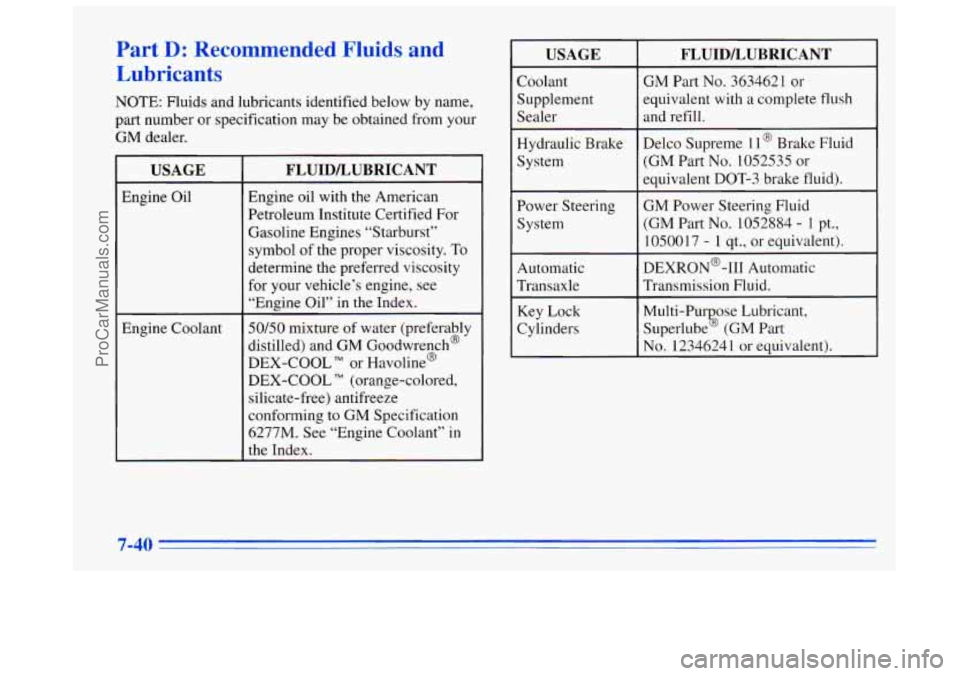
Part D: Recommended Fluids and
Lubricants
NOTE: Fluids and lubricants identified below by name,
part number or specification may be obtained from your
GM dealer.
USAGE
Engine Oil
Engine Coolant
FLUIDLUBRICANT
Engine oil with the American
Petroleum Institute Certified For Gasoline Engines “Starburst”
symbol of the proper viscosity. To
determine the preferred viscosity
for your vehicle’s engine, see
“Engine Oil” in the Index.
50/50 mixture of water (preferably
distilled) and
GM Goodwrench@
DEX-COOL
TM or Havoline@
DEX-COOL (orange-colored,
silicate-free) antifreeze
conforming
to GM Specification
6277M. See “Engine Coolant” in
the Index.
USAGE
Coolant
Supplement
Sealer
Hydraulic Brake
System
Power Steering
System
Automatic
Transaxle
Key Lock
Cylinders
FLUIDLUBRICANT
GM Part No. 3634621 or
equivalent with a complete flush
and refill.
Delco Supreme 11
@ Brake Fluid
(GM Part No. 1052535 or
equivalent
DOT-3 brake fluid).
GM Power Steering Fluid (GM Part
No. 1052884 - 1 pt.,
1050017 - 1 qt., or equivalent).
DEXRON@-111 Automatic
Transmission Fluid.
Multi-Pur ose Lubricant,
Superlube
b (GM Part
, No. 1234624 1 or equivalent).
ProCarManuals.com